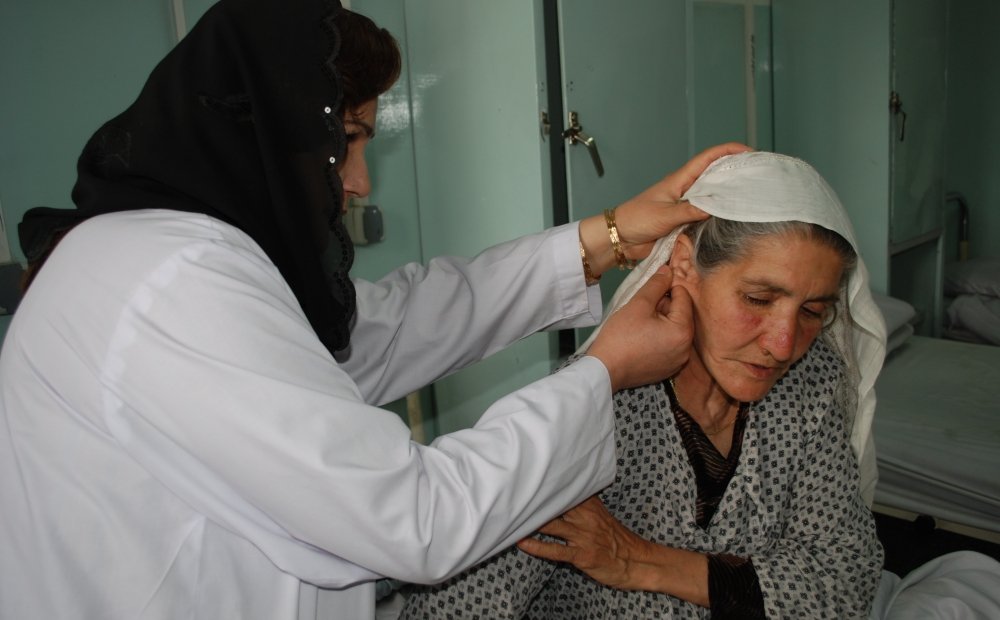Afghanistan's Emerging Health Portrait: A Dialogue with Afghanistan's Minister of Public Health

Claude Allen applauded the Afghanistan Ministry of Public Health on its efforts to improve the state of healthcare in the country. Allen said that the partnership between the U.S. and Afghanistan aims to reestablish functioning healthcare systems and seek long-term improvements rather than quick fixes. Much of the efforts, he explained, emphasize prevention versus treatment, focus on responding to needs of those in rural areas, and target women and children, who are the most vulnerable members of society—especially in terms of high infant mortality rates. Allen cited women's and children's health as the number one priority of a coordinated approach sustained by multiple agencies including USAID, the Department of Defense, the State Department, and the Department of Veteran's Affairs. Allen commented that rebuilding the infrastructure of Afghanistan's healthcare system is a tremendous challenge but not an impossible one, given the exceptional vision of Afghanistan's Minister of Public Health, Sayed Mohammid Amin Fatimie.
Minister Fatimie opened his remarks with a brief history of Afghanistan and the conditions that led to the rise of the Taliban, the emergence of al-Qaeda, and the U.S. invasion of 2001. The Minister highlighted various improvements to the healthcare system that have transpired during the U.S. presence, but he added that more time is needed to repair the problems and essentially rebuild the entire system into one of transparency and efficacy. The emergence of free press in Afghanistan is helping to make healthcare needs more apparent to the necessary parties, and provincial governors are actively pressuring national leaders for more action, he reported. Some of the main concerns to be addressed include the growing gap between urban and rural healthcare conditions, the prevalence of mental health illnesses, the insufficient number of doctors and facilities, and the preponderance of outdated and limited medical equipment. The Minister noted that the most substantial and expensive challenge for the Ministry is improving hospital care by training practitioners and providing modern facilities. Currently, twenty-five percent of 3,700 physicians are women; by 2009, the Ministry of Higher Education plans to train 20,500 physicians—10,500 of whom will be women. The Minister concluded by observing that Afghanistan has the necessary resolve to promote its own development, but that the international community needs to stand by Afghanistan and provide the necessary financial assistance for improving facilities and training doctors, nurses, and other members of the public healthcare system.
Jim Kunder spoke about his initial visit to the Ministry of Public Health in Kabul, Afghanistan, describing an environment that lacked electricity and heat—yet provided shelter to amputees who lacked another facility in which to take refuge. Despite these conditions, Kunder observed that employees of the Ministry of Public Health were dedicated to their mission. Representatives are posted throughout Afghanistan and continue to work, regardless of the fact that they might not have been paid or been in contact with the home office in Kabul for years. Kunder noted that the backbone of the Ministry's strategy is providing healthcare to rural areas. Attending to rural areas was selected as a priority because of the relative need, the social and cultural reasons prohibiting women from traveling to urban areas for treatment, the pervading aim for inclusion and decentralization of development efforts, and the number of clinics that already existed in the provinces, which formed a basis for success. Kunder explained that continued progress requires a balanced combination of considering the broader context and establishing direct initiatives, such as the encouragement of public-private partnerships.
William Steiger described the involvement of the U.S. Department of Health and Human Services (DHHS) since the early stages of the invasion of Afghanistan. Steiger noted that DHHS' initial focus on improving conditions in Kabul was based on increased healthcare needs related to a higher wartime urban population, as well as the opportunity to provide a model for healthcare that is successful in the capital and could be emulated in the provinces. From administering vaccines to helping improve hospital systems in Kabul, DHHS has aimed to ensure that the indigenous population gains the ability to provide its own healthcare. Developments on this front include increased use of medical records in hospitals, a significant decline in maternal and infant mortality rates, better training for physicians and attendants, and raising awareness about mental health problems such as post-traumatic stress.
Peter Kaivon Saleh highlighted the importance of continued U.S. support of the Ministry of Public Health, noting that healthcare is a top priority for the Afghan government, second only to security. Saleh stressed the need for long-term strategies for rebuilding the healthcare system. In particular, approaches must address the considerable increase in opium production, the ethnic diversity of Afghanistan's population, the particular challenges of urbanization, and the disturbingly low life expectancy rates for Afghans—especially women. Afghanistan has only three teaching hospitals and eight professors to train about 10,500 students; similarly, only 4,000 qualified pharmacists exist to run 14,000 pharmacies—and thirty tons of poor quality drugs have been destroyed, even though increased inspection has caused a shortage of medicine. Training new practitioners and re-training existing practitioners is a significant and critical task. Afghanistan has recently created a Board of Certifications to ensure that all doctors, nurses, pharmacists, and assistant pharmacists are subject to national requirements. Saleh also described the productivity of a vertical system of management that enables integration among urban hospitals and regional clinics. In conclusion, Saleh reflected upon the need for monetary donations from the international community—improved management of hospitals and the empowerment of Afghans are reliant on such support.
This event was cosponsored by the Wilson Center's Middle East Program and Global Health Initiative, the U.S. Department of Health and Human Services, and the Embassy of Afghanistan.
Speakers


Former Chief of Staff at USAID
Hosted By

Middle East Program
The Wilson Center’s Middle East Program serves as a crucial resource for the policymaking community and beyond, providing analyses and research that helps inform US foreign policymaking, stimulates public debate, and expands knowledge about issues in the wider Middle East and North Africa (MENA) region. Read more


Environmental Change and Security Program
The Environmental Change and Security Program (ECSP) explores the connections between environmental change, health, and population dynamics and their links to conflict, human insecurity, and foreign policy. Read more


Science and Technology Innovation Program
The Science and Technology Innovation Program (STIP) serves as the bridge between technologists, policymakers, industry, and global stakeholders. Read more


Indo-Pacific Program
The Indo-Pacific Program promotes policy debate and intellectual discussions on US interests in the Asia-Pacific as well as political, economic, security, and social issues relating to the world’s most populous and economically dynamic region. Read more


Maternal Health Initiative
Despite global attention and calls to action, women continue to die while giving birth. The Maternal Health Initiative (MHI) leads the Wilson Center’s work on maternal health, global health equity, and gender equality. MHI works to connect issues critical to global health and women’s empowerment to foreign policy and US leadership, with a focus on improving the lives of women, adolescents, and children around the world. Through collaborations with policymakers, academia, donors, and practitioners, MHI produces cutting-edge research, fosters cross-sectoral engagement, increases awareness of key issues, and informs US leadership on solutions for ending maternal and newborn deaths and addressing gender-based global health issues. Read more
